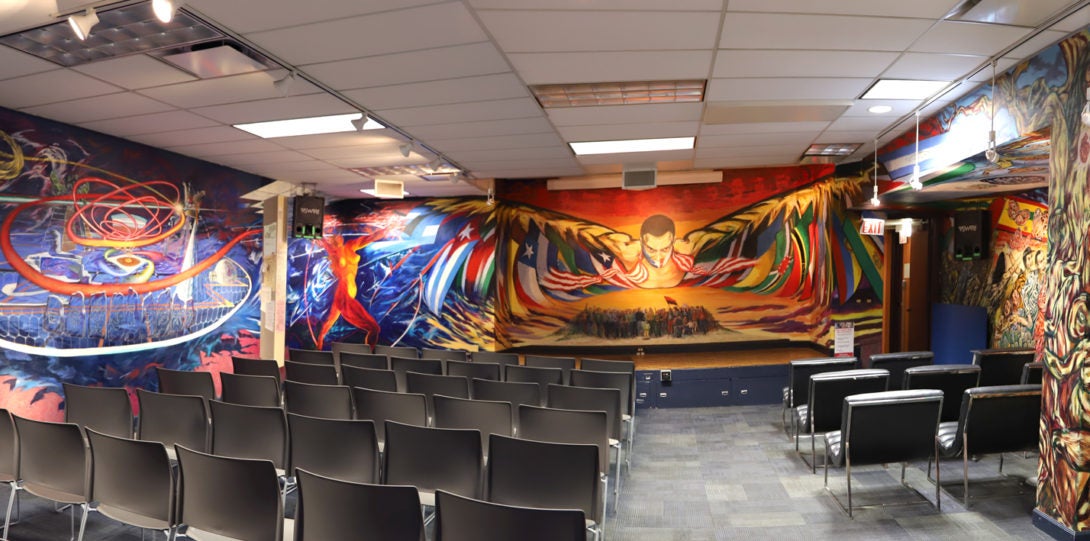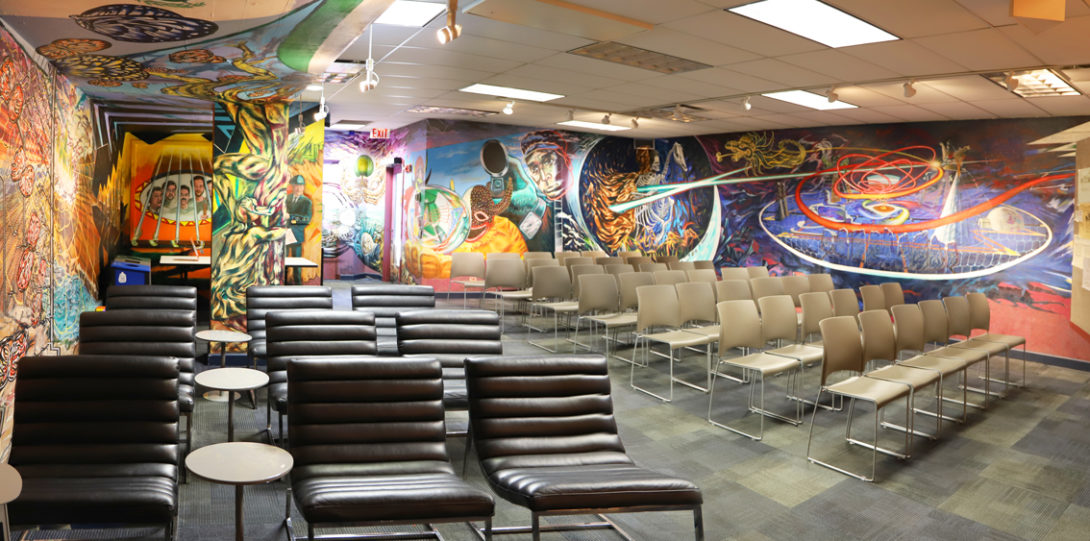“El Despertar de las Americas” (The Awakening of the Americas) Mural
Text
The Latino Cultural Center (LCC) houses the largest contemporary indoor mural in the City of Chicago. The mural is called El Despertar de las Américas (The Awakening of the Americas) and was completed in 1996 by Chicago muralist, Maestro Hector Duarte. The artist worked with a group of UIC Latine students in the selection of topics for the mural and its execution. Although the topics were a reflection of social life in the mid-nineties that included concerns about identity and stereotypes, immigration, gender roles, human rights, poverty, and education—they remain relevant in Latine communities today. In the summer of 2011, the artist returned to restore the mural and add a new section that highlights the transnational lives and global concerns of Latinas and Latin American women.
Since 2012, one of the LCC staff’s priorities has been to animate The Awakening of the Americas mural to
1) teach and learn for equity and social justice, and 2) expand cultural understanding among people of different backgrounds and identities. The LCC staff has been accomplishing this through tours of the mural and their Arts-Based Civic Dialogues Initiative (ABC Dialogues). As of 2016, these have engaged over 5,000 UIC students, faculty/staff, community members, and especially high school students. The different scenes in the mural serve to spark these dialogues and tours by linking cultural heritage to contemporary life. However, the LCC staff experienced that a few scenes in the mural were very limiting. Thus in the spring of 2015, the LCC staff conversed with Maestro Duarte to address this, and also consulted with their Ambassadors Group to collect feedback. Maestro Duarte considered the suggestions but ultimately had artistic license. The LCC staff engaged with the artist in discussing more philosophical questions such as:
1) When does public art become a record of history? and 2) When is it open to revisions (consented by the artist) to infuse relevancy to contemporary life and link the past to the present? The revisions to the mural were relatively minor, and included issues such as environmental and climate justice. Thus, they came to a middle position on the questions above, and the mural was revised once again in the summer of 2015.
- If you are interested in conducting your own dialogue on-site, check out the ABC Dialogues Guide [PDF]. For more information, see Dialogues & Tours.
- To learn more about the artist, Hector Duarte, check out his website here, or other articles here, here, and here.
Awakening of the Americas
The Warrior Eagle

The figure depicted in this section is referred to as a warrior eagle whose feathered wings are adorned by Latin American flags. The U.S. flag here represents a dominant culture that tries to silence Latino voices in the making of U.S. history. His pierced eyes speak about the persistence of Latinos in reaffirming their cultural identity while they claim social rights and recognition as active citizens in society. Above the warrior eagle, a collection of Latin American and Latino historical figures who were/are active in social justice movements provide inspiration and wisdom to the warrior eagle in his journey for social equity.
The crowds of people in this scene below the warrior eagle remind us of the power of unity. El Movimiento, or the protest march, has been a tradition for social action among working class people of Latin America. In the U.S. today and right here at UIC, movements continue to inspire collective change.
The American Dream
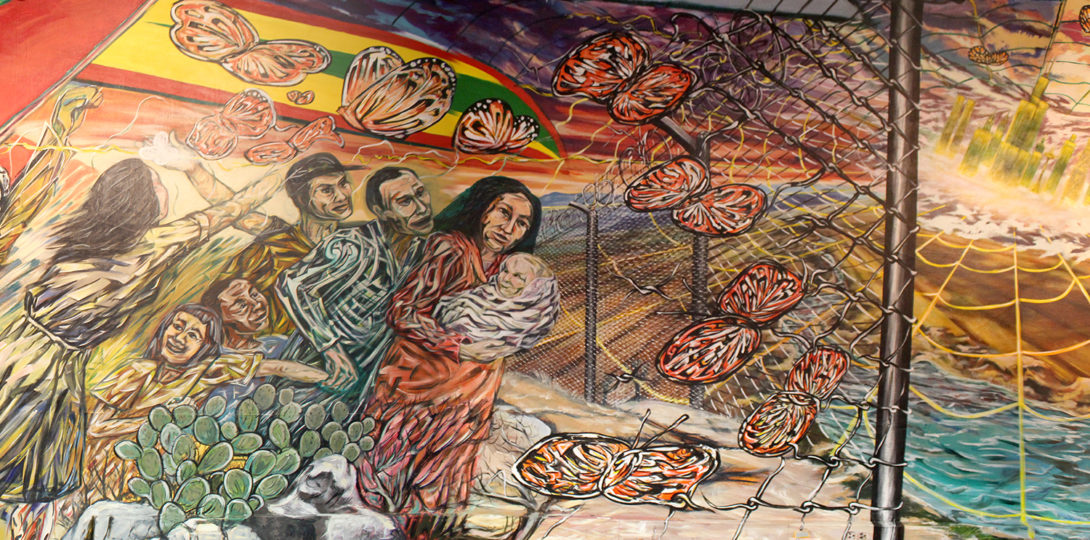
The American Dream includes the promise of economic prosperity that has prompted people from all over the world to immigrate to the U.S. This scene presents us with the journey of immigrant families departing from their homelands and crossing national boundaries. The troubled waters and chain-link fence demark these boundaries. Monarch butterflies tear apart the fence and float away free. The migration of the Monarch across North America serves as a powerful symbol for many people who have followed a similar natural path across the continent. The families in the mural strive for arrival at a gateway city that promises job opportunities. However, the American Dream is illusory and the reality is working lengthy hours in factories for low wages under hazardous conditions. The spider web represents the entrapment of immigrants in a capitalist system that produces an enormous amount of wealth for a small number of people and perpetuates high levels of inequality and oppressive conditions for the working class. At the center of the American Dream, questions about what or who is “American” remain at the forefront of our most heated national discussions.
Pillars of the Family

This scene presents us with the pivotal role of Latinas and Latin American women as mothers and pillars of the family. Traditionally, these women have been expected to prioritize their family and subdue desires of independence and professional development until they fulfill their roles as nurturers and caretakers. Those who have defied this expectation have shown the versatility and resilience of Latinas and Latin American women as they take on multiple roles and achieve their self-defined dreams.
Political Activism and the Arts

This section draws parallels between political activism and the role of the arts as a conduit to express the concerns and aspirations of our communities. The artist uses guitar strings as a metaphor for prison bars and pays tribute to a group of artists with a long tradition of speaking out against social injustices. Illustrated is David Alfaro Siqueiros, known as one of the artistic masters of the twentieth century and a member of the Mexican school of mural painting that includes José Clemente Orozco and Diego Rivera. Siqueiros’s political activism resulted in many deportations and years in jail where he created most of his easel works. Other figures behind the bars represent the independistas of the 1980s who were trying to call attention to the cause of Puerto Rican independence from the U.S. Members of this group were arrested and refused to testify at their trials, stating they were being held as prisoners of war and the U.S. courts had no right to try them. They received federal sentences of 35 to 105 years each. Lacking evidence, the government portrayed their refusal to testify as equivalent to an admission of guilt.
The woman being arrested is Dolores “Lolita” Lebrón Sotomayor, a poet and activist who committed her life to ending U.S. colonial control of Puerto Rico. She visited the Latino Cultural Center in 1997 and left us the gift of her signature on this mural.
Global Citizen
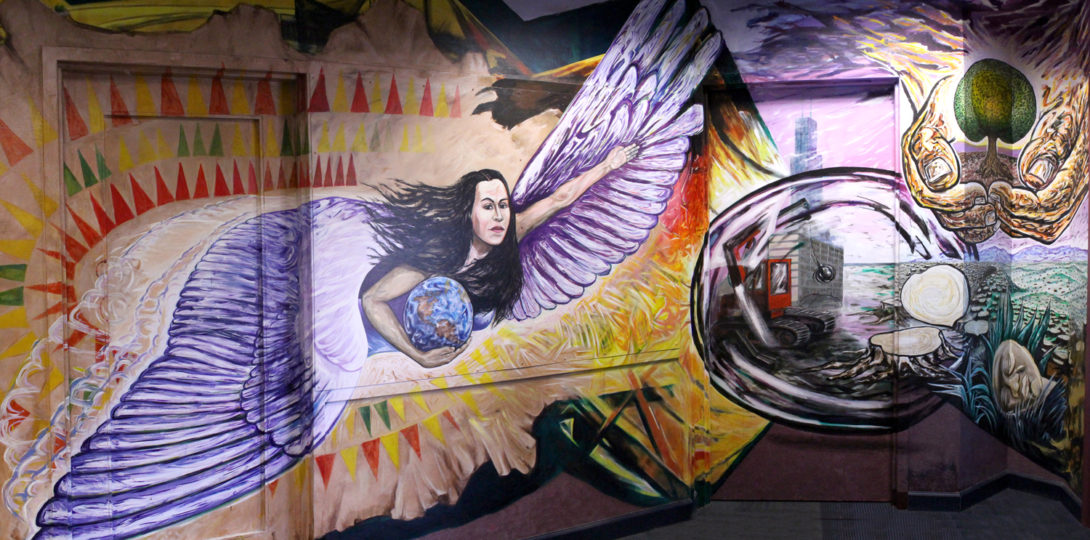
In this entryway, the artist connects different events that have disrupted and altered our cultural landscape. Urban destruction and rural deforestation are illustrated in parallel, emphasizing the connection between endangered human cultures and our natural world. Soaring in from the left is a 21st century Latina woman whose experiences, aspirations, and commitments make her a global citizen. She is taking advantage of her cultural resources by harnessing her bilingualism, mixed identities, transnational experiences and networks, and traditional knowledge to address environmental issues facing our planet. Diverse communities right here in Chicago are working for community development through sustainable initiatives, like establishing community gardens, reusing old materials for new artwork, and opening green businesses. Together as global citizens, we can use our many assets to mobilize and achieve a better world for ourselves, our families, and our earth.
The Vejigante
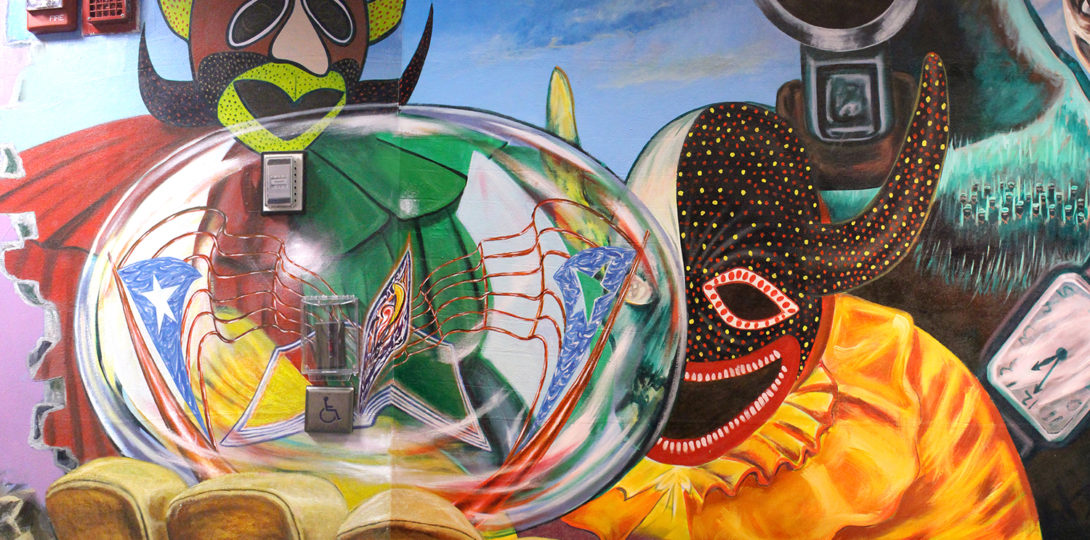
The vejigante represents the battle between good and evil. It was introduced into carnival celebrations in Puerto Rico hundreds of years ago, and it exemplifies the blending of African, Spanish, and Caribbean influences in Puerto Rican culture. The artist uses the vejigante’s double meaning to illustrate the good and evil of community change. Chicago’s Humboldt Park once had a large German population, but the neighborhood transformed in the mid-20th century into the heart of little Puerto Rico. Paseo Boricua is today marked by the large steel Puerto Rican flags that fly over Division Street. Look at this scene from another angle, standing back by the Hub for Social Change, and notice how the bubble connects with the mural scene behind it, and the wrecking ball swings to demolish the flag. As this neighborhood gentrifies today, some neighbors welcome new businesses, while other long-time residents feel pushed out. The debate over neighborhood identity and housing justice fuels tensions today in many communities across our region.
The Zapatistas

The Zapatistas represent a movement that originated among rural people in the southern state of Chiapas in Mexico and, over time, integrated left-wing intellectuals in Mexico City into its leadership. The group takes its name from Emiliano Zapata, a leading figure in the Mexican Revolution, and it continues to seek empowerment of indigenous people over their local resources, especially land. The Zapatistas believe that people’s voices need to be heard in the discussions and decisions that affect their lives. This movement remains popular among marginalized communities all over the world and especially among young people who see themselves as agents of change.
Quetzalcoatl in Disguise
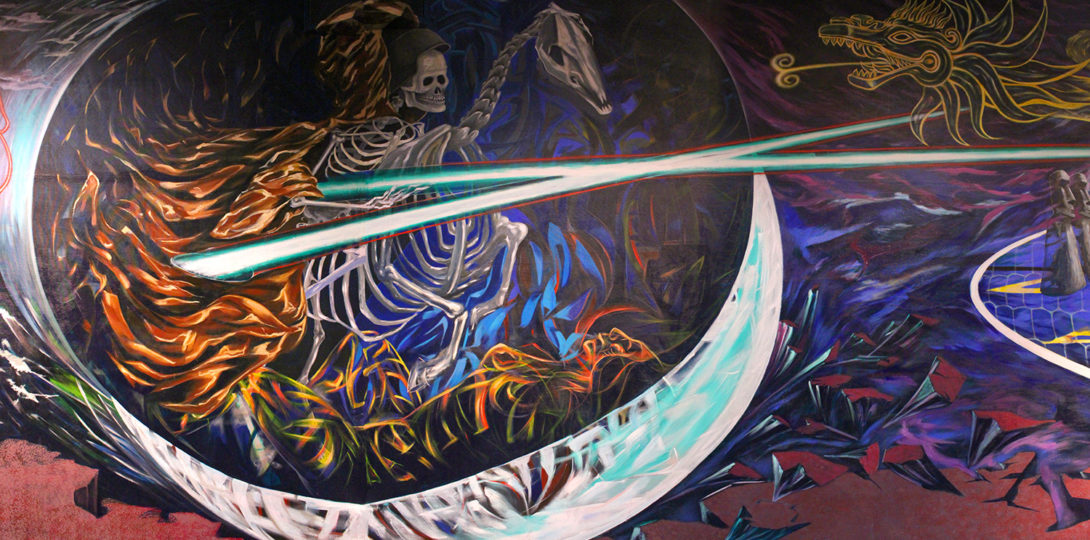
This scene is about the arrival of the Spaniards in the Americas and their efforts to destroy indigenous cultural practices and impose European beliefs and values, including religion. The horse rider or “jinete” represents the Spanish invader who initially was mistaken as Quetzalcoatl by the Aztecs. Scholars of Mesoamerica have argued that the Aztecs were welcoming to the Spaniards when they first arrived because they thought that Quetzalcoatl was among them. According to Aztec history, Quetzalcoatl was a feathered serpent deity and high priest-ruler of the Toltecs who was also a mythical ancestor of Aztec rulers. This deity left Central Mexico in the ninth century to sail on the ocean with the promise to return. When the Spaniards landed on the shores of Yucatan, the Aztecs thought that Quetzalcoatl was finally returning to the homeland.
A Hub for Social Change
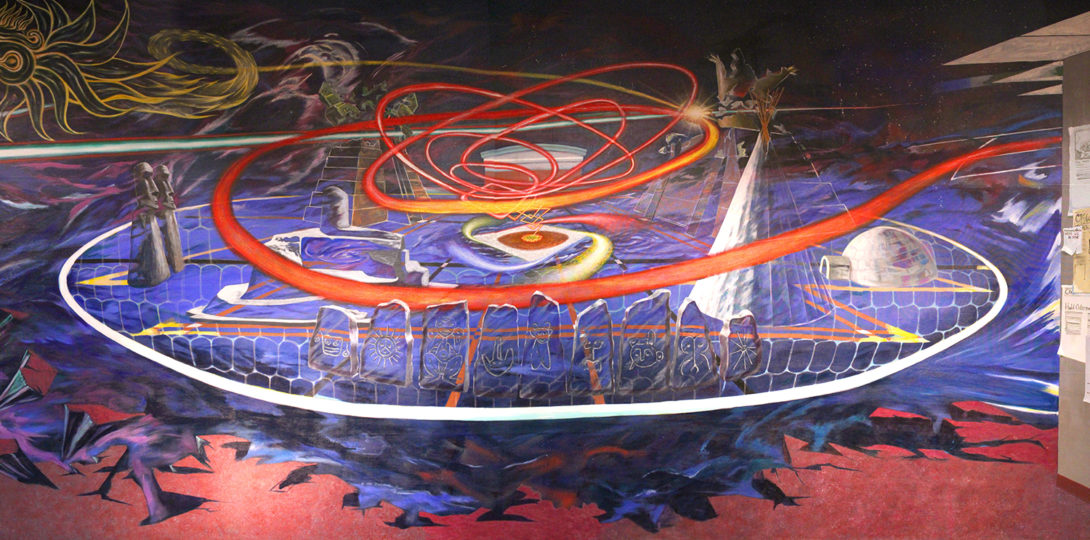
This scene represents the role of the Latino Cultural Center as a hub where UIC Latinx students, all other students, faculty, staff, and neighboring communities meet to deepen their understanding about the cultural heritage of Latinx communities and connections to other cultures. The LCC strives to help Latinx students on campus shape a positive self-defined identity by linking their histories to contemporary life, engaging in intercultural dialogues, and supporting coalitions for positive social transformation.
In this scene, the LCC is situated in front of an open area (the UIC Quad) where people have traditionally congregated to celebrate, mobilize against injustices, socialize, or simply enjoy the outdoors during warm days. Plazas and markets are important public spaces in Latin American countries, and the artist draws parallels between the Zócalo of Mexico and the UIC Lecture Center Plaza. Inside the plaza, various ancient American cultures reunite, including the Maya and Aztecs from Mesoamerica, the Taínos from Puerto Rico, the Incas from the Andean region, the Polynesian culture of Easter Island off the shore of Chile, and various North American tribes. The message is that there is power in unity, and our cultural heritage can help us understand who we are, where we are in the present, and how we can shape a better future for others and ourselves.
The Wisdom of Cultural Heritage
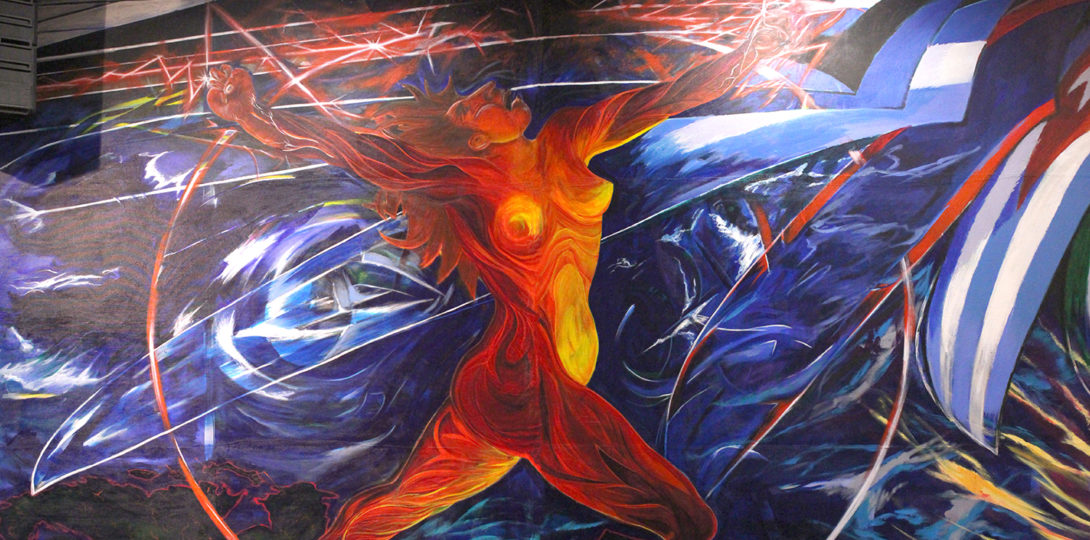
Here, the artist shows an indigenous woman as a symbol of resilience and resistance to colonization and 500 years of imposed cultural values. With one foot stepping into the Latino Cultural Center (LCC), this woman awakens the people of the Americas to their past and its connection to the present. The role of the LCC is to mobilize the wisdom of cultural heritage for social change. The main message in this scene is that history is a powerful tool for making decisions about the present and helping us shape the future.
El Corazón
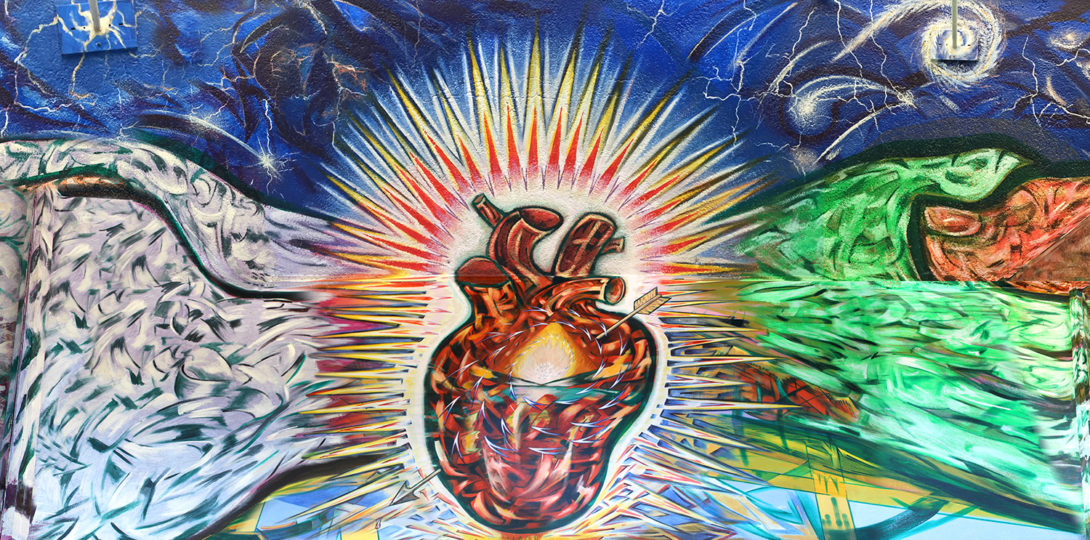
There is a saying in Spanish, con el corazón en mano, which implies that someone is coming to you or welcoming you with honest and peaceful intentions. The heart with the flame signifies love and passion; some ancient American cultures believed that fire within the heart drove warriors to fierce battles, and therefore the heart was the highest gift that they could offer to their gods and goddesses.
Four hands that represent solidarity between different cultural groups frame the heart in our mural. The Latino Cultural Center (LCC) is a home for Latinos on campus as well as neighboring communities. The Center extends a warm welcome con el corazón en mano to anyone who wishes to expand their knowledge about the cultural heritage of Latino communities and promote the value of cultural diversity.
Our Essence, Our Presence
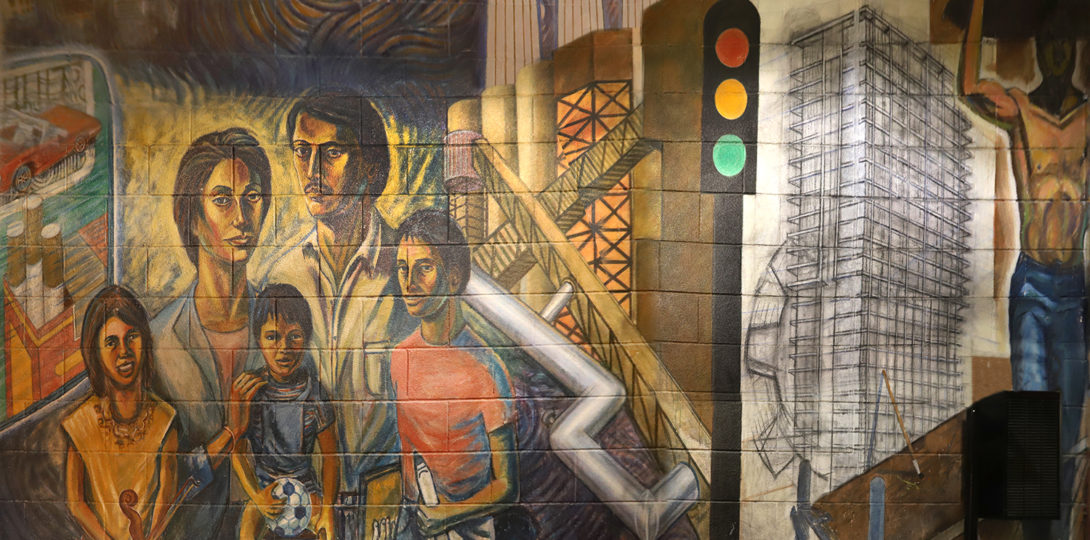
This scene is the last remnant of a mural painted in 1985. It depicts a traditional family structure in the midst of a capitalist and industrial society, and how the children of Latina/o immigrants are challenging the educational status quo. To explore the past mural, check out “Our Essence, Our Presence.”
